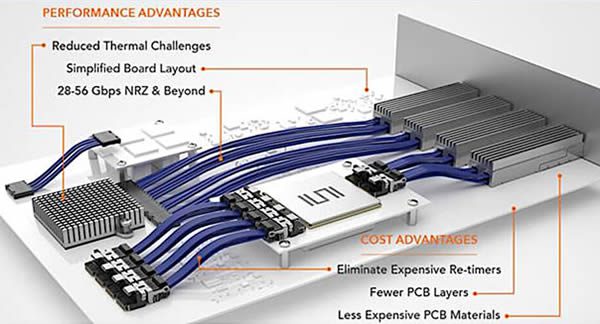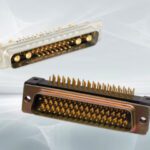Cables, Connectors, Waveguides, and Hybrid Products for up to THz at IMS 2023
IMS 2023, the premier worldwide RF microwave symposium, revealed exponential gains in next-generation interconnects for wireless communications technologies. Take a tour of the highlights with RF expert Dave Shaff.
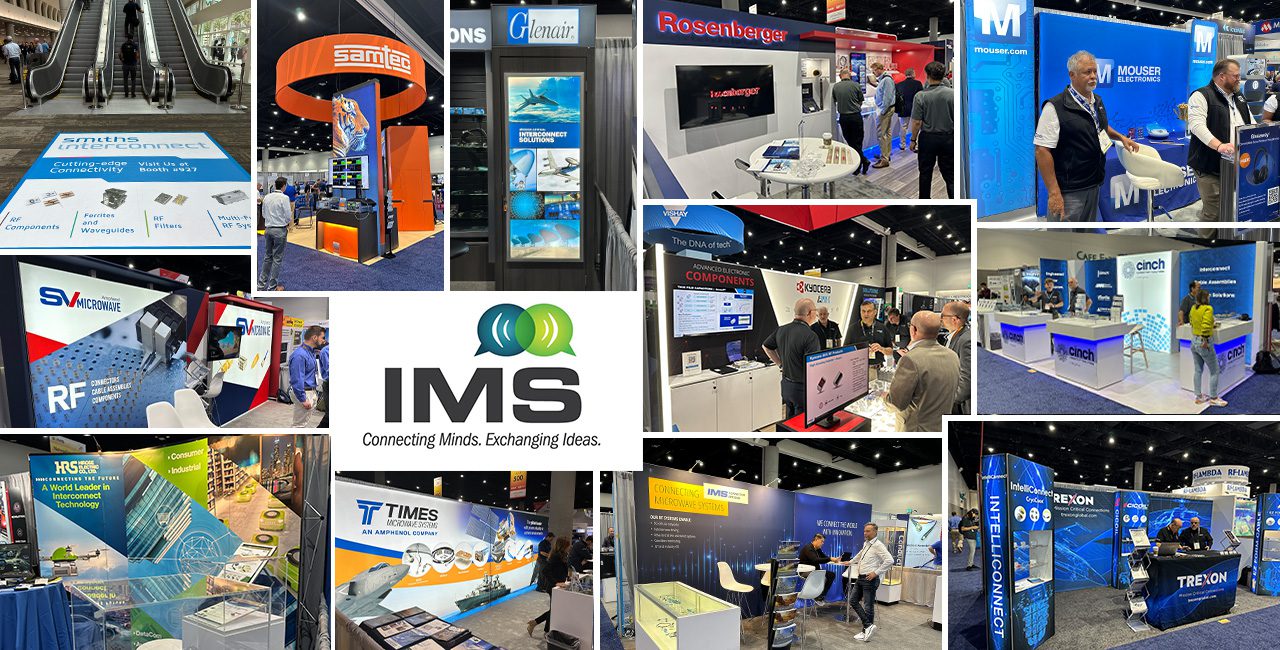
This year’s International Microwave Symposium (IMS) reestablished the event as the premier world level expo for RF through THz technology, engineering, and products. IMS 2023, held June 11-16, in San Diego, co-located this year with the RFIC Symposium, the ARFTG Microwave Measurement Conference, and, for the first time, with the IEEE Women in Engineering International Leadership Conference. The COVID-19 pandemic significantly impacted IMS, but 2023 brought over 9,000 registered attendees and more than 550 exhibitors, versus an estimated 6,300 attendees and 450 exhibitors in 2022).
The show covered a broad range of wireless communications technologies, including 6G developments, Wi-Fi, RF and microwave system-on-chip integration, massive MIMO systems and subsystems, plus wireless power transfer, automotive systems, and model-based systems engineering, including digital twins, deep space, and aerospace, in addition to medical applications. A good amount of buzz centered on sub-terahertz and waveguide technologies.
New products for test equipment
The newest assemblies first require test equipment, which incorporates and exhibits the latest interconnect technology. Anritsu’s new 70 GHz Rubidium MG36271A RF/Microwave Signal Generator was shown integrated with frequency extender modules from Virginia Diode Inc. (VDI) for sub-THz solutions. Its VectorStar ME7838x4 Broadband systems mmWave module uniquely uses 0.6 mm test port connectors for measurements up to 220 GHz. (Last year’s IMS review covered its VectorStar VNA with 0.8 mm module connectors to cover 70 kHz to 145 GHz with one sweep that was also shown this year. Other capabilities shown extend up to 1.1 THz.)
Keysight’s presentations focused on hardware and software solutions to enable accelerating 5G and pioneering 6G, and for RF advances in non-terrestrial networks (NTN) and internet of things (IoT) networks, while demonstrating Open RAN (Open Radio Access Network using software from different vendors) and Over-the-Air (OTA) testing for 5G massive MIMO equipment. Keysight’s 6G Vector Component Analyzer joint solution with Nokia Bell Labs offered wideband measurements in the sub-terahertz (sub-THz) D-band. Keysight used optimized 1 mm connectors for 125 GHz, with other higher frequency solutions incorporating waveguides.
Rohde & Schwarz also presented sub-terahertz and 6G applications. Its FE170ST front-end-extender (RF output uses WR-6.5 WG) increases the frequency of its signal and spectrum analyzers, plus signal generators, through 170 GHz. The company also displayed the ATS1800C CATR-based 5G/6G over-the-air (OTAS) test chamber for evaluating antennas, modules, and other devices from R&D to production spec-conformance. R&S was one of the original proponents of the 1.35 mm connector and this was used on many of the assemblies displayed at IMS 2023.

To take advantage of newer VNA capabilities, higher speed wafer probes were displayed by BGG Industries (Picoprobe), FormFactor, and Signal Microwave.
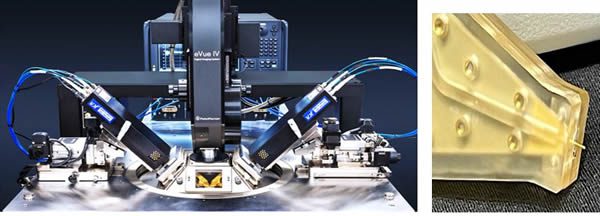
At left, FormFactor probe used with VDI extenders. At right, probe by Signal Microwave with 0.6 mm tip for sub-THz processing speeds. Signal Microwave also showed its new non-magnetic connectors to 40+ GHz for quantum computer applications.
IEEE MOVE program equipment for first responders
One of IEEE’s three special MOVE (Mobile Outreach VEhicle) trucks was displayed outside the convention center to present the work IEEE provides for disaster relief. Staffed by skilled IEEE volunteers, the vehicles are brought to natural disasters to support Red Cross and other first responders by providing capability for high-speed satellite uplink for Wi-Fi internet and communications, 900W solar panel array for recharging on‐board batteries, plus capabilities for Ethernet, IP telephone, videoconferencing, and Direct TVTM link for news, weather, etc. When not deployed for natural disasters, the IEEE MOVE volunteers conduct community outreach educational opportunities. Although the IMS Symposium focused on new technology and hardware, MOVE is an example of how IEEE uses its membership and RF technology for social benefits.

IMS showcases new interconnect components.
VITA standards cover many connectors shown at IMS 2023. SV Microwave (Amphenol) presented new VITA 67.3 contact terminations for both SMPM and SMPS series. SV Microwave is an associate member of the SOSA Open Group and an active participant of the SOSA Electro-mechanical hardware group, which is reflected by its VITA 66.5 RF/Fiber Hybrid connectors and lighter weight aluminum VITA 67.3 connectors. Smiths Interconnect offers a similar LightCONEX LC Series of optical plug-in and backplane module connectors. For optical VITA 66 applications, Samtec displayed the cabled FireFly™ Micro Flyover™ System.
Samtec and Molex have collaborated for a common approach for next-generation data center interconnect, resulting in a licensed source agreement for the Samtec Twinax Flyover™ and Molex BiPass systems for high-speed data (56 Gb/s and 112 Gb/s) speeds. Board assemblies can only handle so much while keeping layers (transmission loss) at a minimum, which prompts considerations for flyover products.
Saving weight is critical for many applications, including soldier and medical wearables, home health devices, space applications, aircraft, portable instruments, etc. Interconnects play a role in keeping application weight down, and SV Microwave showed UltraLite SMA and 2.92 mm connectors with gold-over-nickel-plated aluminum housings to meet that need. Assemblies using Ø.047” cable are 66% lighter than stainless steel counterparts.
Engineers at Delta Electronics Manufacturing’s booth also stressed materials technology. Delta is working on extreme high temperature coax connectors for hypersonic missile applications (not yet released). Thermal and other environmental requirements are a magnitude above firewall connectors such as Amphenol Aerospace’s BT-M connectors that can handle 2K ˚F for up to five minutes and illustrate the extremes needed for future RF connectors.
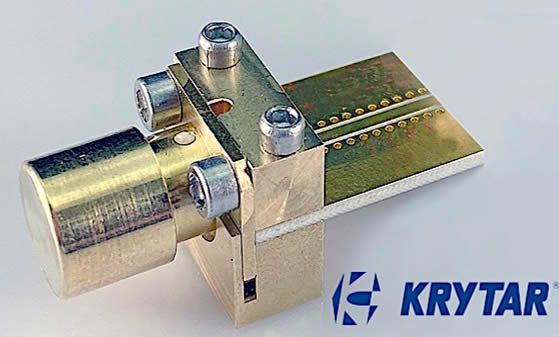
Rather than adding on separate terminations, Krytar introduced its 0.5 W End Launch (board mount) chip terminations from DC to 27 GHz with 1.4:1 VSWR, based on patent-pending technology, to simplify installation and reduce parts’ cost versus typical thread-on coaxial terminations.
Connector and cable assembly providers without a 1 mm series (typically for DC to 110 GHz) are now the exception as 1 mm interconnect was shown by most exhibitors of microwave connectors/cables. The IEEE 287 Standard for test connectors that was released/updated last year defines 1.35 mm, 0.8 mm, and clarified 1 mm dimensions.
Although 1.35 mm connectors for E-Band applications (DC to 90/92 GHz) are relatively new, they were presented at IMS by many manufacturers, including Rosenberger, Samtec, SPINNER, Southwest Microwave, CentricRF, and Frontlynk. ERAVANT has 1.35 mm to WR-12 waveguide adapters for test systems. Many suppliers had 1.35 mm to 1 mm adapters for test applications.

RPC 1.35 mm coax connectors, cable, and adapters by Rosenberger
About a half-dozen firms exhibited 0.8 mm connectors. When asked, “To what standard is this designed?” only one company mentioned the IEEE 287 standard. Another said, “We make both sides.” The 0.8 mm primarily is intended for use in tightly toleranced, expensive test equipment where different suppliers would be expected to provide the chassis versus attaching cables. Hopefully, connector saver-adapters may prevent damage caused by ill-matched interfaces.
0.8 mm to 1 mm adapters for DC to 145 GHz were shown by Anritsu, Yuetsu Seiki, and Withwave, while Waka Manufacturing (Tokyo) and Flann Microwave (UK) displayed 0.8 mm to WG adapters. Yuetsu Seiki and Junkosha displayed 0.8 mm and 1 mm connectors with plugs for .047 mm cable.
New cables extend performance
Limitations of supply for higher frequency cables that offer stability, low loss, and quality construction were addressed as several firms recapped new production plans. The .047 mm flex cable by Temp-flex (Molex) often is considered the target for cable houses to duplicate. Flexible .047 mm and other mmWave cables are planned by Samtec using its new Pennsylvania facility. New sources underway for cable include Samtec, Times Microwave Systems (Amphenol), and evissaP. EZ Form Cable (Trexon) displayed cable that included .047 mm conformable types. Both evissaP and Waka Manufacturing (Tokyo) showed unique armored 110 GHz test cables with 1 mm connectors.
Push-on SMA connectors may permit quick-test cycling, but the connectors often have wear problems, making them unsuitable for test applications. However, Custom Cable Assemblies (Warner Robins, GA) offers them with a different, patented design that permits several thousand matings.
Southwest Microwave Inc. (SMI) offered a low loss 1 mm to 1 mm assembly using .031” dia. SR cable for 125 GHz applications. To support lighter weight and miniaturization, SMI also showed its 0.9 mm SuperMini Series for applications up to 67 GHz.
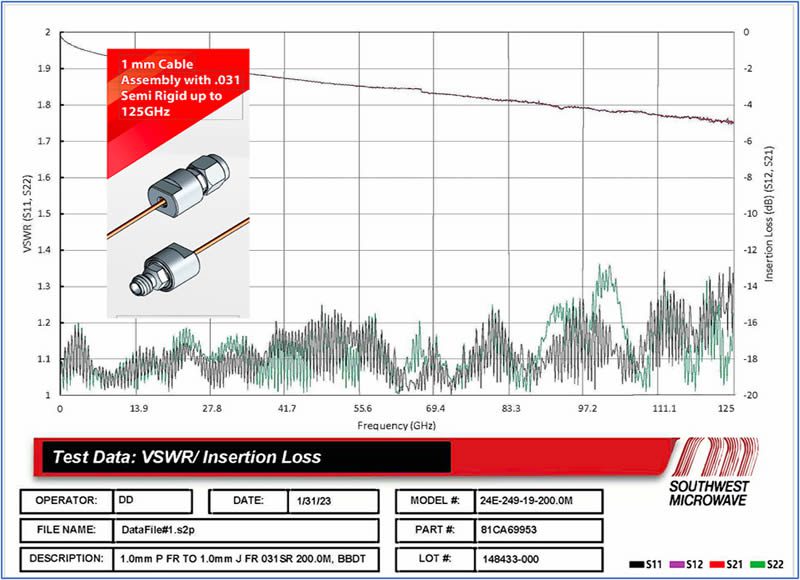
This was the second time that Glenair Inc. exhibited. The company showed extensive RF capabilities for aerospace interconnect, including multi-port coaxes in MIL-connectors.
Molex recently combined its RF interconnect and Temp-flex cable groups to provide a more unified response for the RF marketplace. Roger Kauffman, senior director of product management and marketing at Molex, discussed directional antenna assemblies for 5G hybrid inline and wire-to-board connectors for automotive applications, connecting wearables for the medical industry, higher interconnect functionality for networking centers, and other multi-technology innovations.
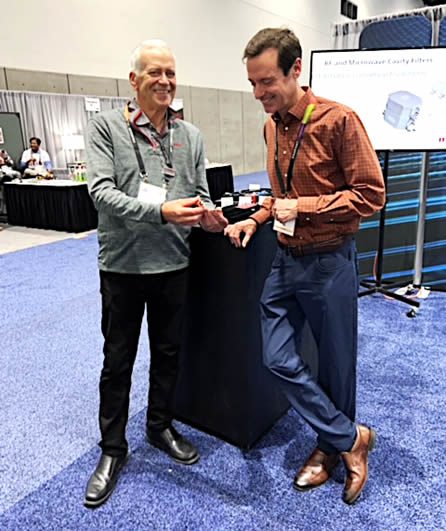
Roger Kauffman, senior director of product management and marketing at Molex (left) in discussion with John Bishop, managing director of Connector Supplier (right), at the Molex booth.
The extent of creative new products presented at IMS 2023 was outstanding. More new products were exhibited than could be included in this short article, from 110 GHz WR-10 waveguide switches by Logus to the 15+ GHz mini-FAKRA and watertight IP68-rated 4.3-10 communication connectors by IMS Connector Systems. Based upon the rate of new RF microwave advances we saw this year, IMS 2024 will be a great event and we look forward to joining you there. IMS 2024 will be held June 16-21, 2024, at the Walter E. Washington Convention Center in Washington, DC.
Market forecasts and product information on RF interconnect is detailed in the report World RF Coax Connector Market 2023 by Bishop & Associates.
To learn more about the companies mentioned in this article, visit the Preferred Supplier pages for Amphenol Aerospace, Molex, Rosenberger, IMS Connector Systems, Samtec Inc., Smiths Interconnect, SV Microwave, Times Microwave Systems, and Trexon.
Like this article? Check out our other RF and Coax, Trade Shows, our Mil/Aero Market articles, and our 2022 and 2023 Article Archives.
Subscribe to our weekly e-newsletters, follow us on LinkedIn, Twitter, and Facebook, and check out our eBook archives for more applicable, expert-informed connectivity content.
- New Circular Connectors Add to Multi-Billion Dollar Market - January 9, 2024
- Counterfeit Components Ground Airlines - December 12, 2023
- Cables, Connectors, Waveguides, and Hybrid Products for up to THz at IMS 2023 - July 11, 2023
